| The conifers form the dominant climax vegetation in the colder parts of the temperate region. Despite their scarcity in the tropics we will look at this group which is of world wide economic importance as a source of timber and pulp for paper. |
|
|
Leaves, simple (not-pinnate), highly-reduced and generally evergreen
|
|
| They show vigorous secondary growth with little or no pith. As for other plants considered so far they have no vessels in their xylem, only tracheids. | Biodisc photomicrograph |
|
| Ovules borne on a scale, exposed to the air (as for other gymnosperms). |
|
While most conifers are evergreen a few, such as larch, shed
their leaves in winter
The tree at right, Araucaria heterophylla, the Norfolk Island Pine, is widely cultivated in the Caribbean but comes from the Pacific. It has sister species like the Monkey Puzzle tree, Araucaria araucana, in the Andes of Chile. The evolution of the conifers occurred at the same time as the separation of the continents which explains the present day distribution of the group. Click on Pangea VR to see this. |
| Trivia time: the
Barbadian conifer that never was... The species Juniperus barbadensis was described from a specimen supposedly collected many years ago in Barbados. Over the years, botanists tried to find this plant again without success. A few years ago, it was rediscovered on the summit of one of the Pitons in St. Lucia. It seems unlikely this plant was ever present on relatively-flat Barbados. It seems more likely that a mistake was made in the collecting expedition many years ago in recording the plant's origin. So... despite the name barbadensis (=of Barbados), it isn't! |
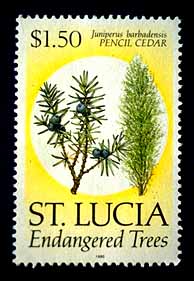 |
| Even to this day new conifers are being described! A case in point is the Wollemi pine discovered in 1994 in Australia. It is a relative of Auraucaria. |
| Pines are monoecious, each tree bearing both male
& female cones. The Pine family includes Christmas trees (like the Norway
Spruce) and firs, but is typified by members of the genus Pinus. While most
members live in cold northern climates, one species, Pinus caribaea, the Caribbean Pine, is cultivated on the more mountainous islands of the
Caribbean. It is native to the Bahamas, Cuba and Central America. It bears needle-like
leaves in clusters of three. |
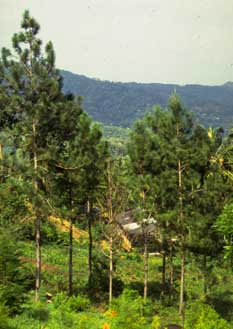 |
| Most pines have leaves with a low surface to volume ratio, viz. pine needles. This and
a thick cuticle relate to the low water availability (frozen soil) for much of the
year. Biodisc photomicrograph |
Male reproductive organs
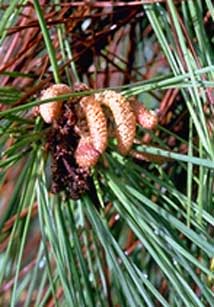 |
The male cone or microstrobilus is simply an axis bearing microsporophylls,
each with two pollen-filled microsporangia. Biodisc photomicrograph0 |
| In the microspore the male gametophyte has been reduced to a single prothallial cell. The air bladders assist the pollen in being blown by the wind to a female cone. | 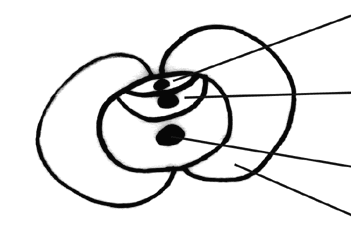 |
prothallial cell generative cell tube cell air bladder |
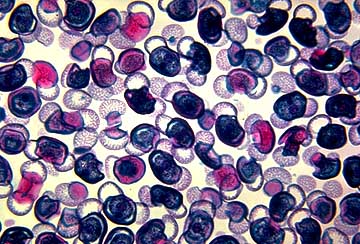 Biodisc photomicrograph |
Female reproductive organs
Biodisc
photomicrograph 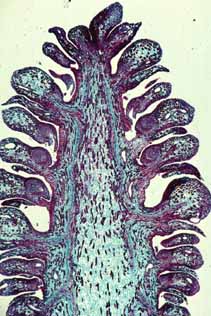 |
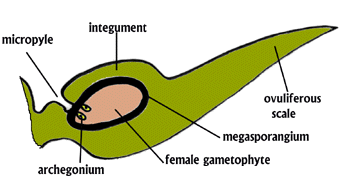 |
The female cone (megastrobilus) is a spiral cluster of
scales each bearing 2 ovules (megasporangia covered by integuments). For reasons that need not concern us the ovuliferous scale is not equivalent to the megasporophyll. |
| L.S. female cone | L.S. ovuliferous scale | . |
|---|
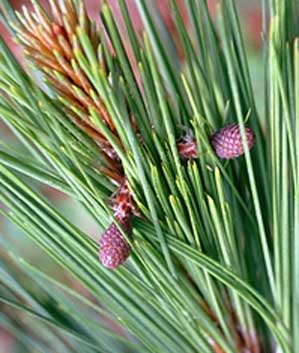 |
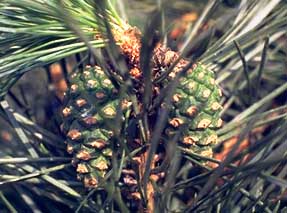 |
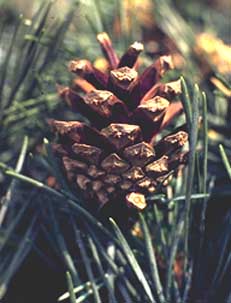 |
| 1st year female pine cones | 2nd year immature female pine cones | 2nd year mature female pine cones |
|---|
| In the temperate regions, it takes a full 2 years for female
cones to fully mature and release seeds. Even in the tropics (e.g. Pinus caribaea),
this process extends into a second year. |
Reproduction
|
Male cones are short-lived, shedding their pollen in spring, then withering and dying. Female cones are long-lived. Pollen grains sift down between the scales of the female cone and are drawn into the micropyle. A pollen tube forms and the generative cell divides. The single megaspore in each ovule
divides initiating the female gametophyte. |
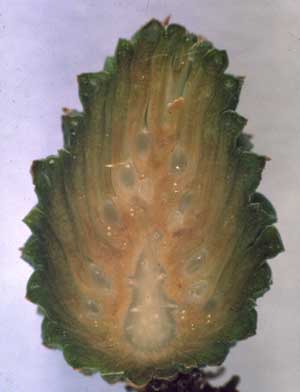 |
Fresh immature female cone split longitudinally - pearl-like ovules conspicuous.
(photo by James Merryweather) |
| . | No further development | until spring of the next year! |
. |
|
The female gametophyte continues to develop, forming
archegonia, each with an egg cell. In the pollen tube, 2 non-motile sperm cells develop from one of the cells formed from the generative cell. |
Pinus female gametophyte developing by free nuclear division. Biodisc photomicrograph |
|
|
The pollen tube penetrates the archegonium releasing the
sperm and fertilisation occurs. The embryo develops initially by free nuclear division. The mature, winged seed is shed, the wind dispersing the new sporophyte
generation. |
L.S. Pine seed with central embryo (blue) with several
cotyledons. Biodisc photomicrograph |
| . | In summary: |
| Like all seed plants, the sporophyte is the dominant generation in the conifers. It is typically a woody plant with highly reduced, non-pinnate leaves. | |
| Microspores and megaspores are produced by cones and all conifers are monoecious. | |
| The gametophyte has been internalised (endospory) and reduced to a single cell in the pollen grain and a few cells within the ovule. | |
| There is a period of 1 year between pollination and fertilisation and up to a further year before maturation and release of the seed. |
| Would you
like to look at some sample questions on this part of the course? If so, click the button. |
| Now that
we have completed your look at the Gymnosperms, click the button for an introduction to flowering plants. |
![]() .
.